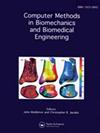A novel fuzzy deep learning network for electroencephalogram classification of major depressive disorder.
IF 1.6
4区 医学
Q3 COMPUTER SCIENCE, INTERDISCIPLINARY APPLICATIONS
Computer Methods in Biomechanics and Biomedical Engineering
Pub Date : 2025-08-25
DOI:10.1080/10255842.2025.2484568
引用次数: 0
Abstract
This study introduces the EEG-FDL model, a novel optimized fuzzy deep learning approach for classifying Major Depressive Disorder (MDD) using EEG data. Integrating deep learning with fuzzy learning via the Non-Dominated Sorting Genetic Algorithm II (NSGA-II), EEG-FDL optimizes fuzzy membership functions and backpropagation. The model handles noise and data uncertainty, achieving a remarkable 99.72% accuracy in distinguishing MDD from healthy EEG signals using 5-fold cross-validation on a large dataset. External validation further confirms its efficacy. EEG-FDL outperforms traditional classifiers due to its effective handling of uncertainties and optimized parameter tuning.
一种新的模糊深度学习网络用于重度抑郁症脑电图分类。
本文介绍了一种新的优化模糊深度学习方法EEG- fdl模型,用于利用EEG数据对重度抑郁症(MDD)进行分类。EEG-FDL通过非支配排序遗传算法II (NSGA-II)将深度学习与模糊学习相结合,优化模糊隶属函数和反向传播。该模型处理了噪声和数据不确定性,在大型数据集上使用5倍交叉验证,在区分MDD和健康脑电图信号方面达到了99.72%的准确率。外部验证进一步证实了其有效性。EEG-FDL由于其有效处理不确定性和优化的参数调整而优于传统分类器。
本文章由计算机程序翻译,如有差异,请以英文原文为准。
求助全文
约1分钟内获得全文
求助全文
来源期刊
CiteScore
4.10
自引率
6.20%
发文量
179
审稿时长
4-8 weeks
期刊介绍:
The primary aims of Computer Methods in Biomechanics and Biomedical Engineering are to provide a means of communicating the advances being made in the areas of biomechanics and biomedical engineering and to stimulate interest in the continually emerging computer based technologies which are being applied in these multidisciplinary subjects. Computer Methods in Biomechanics and Biomedical Engineering will also provide a focus for the importance of integrating the disciplines of engineering with medical technology and clinical expertise. Such integration will have a major impact on health care in the future.

 求助内容:
求助内容: 应助结果提醒方式:
应助结果提醒方式:


